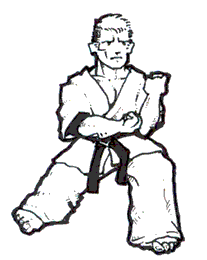On Kata
"On Kata" is reader feedback column designed to elicit your ideas
about kata, their philosophy, structure, strategy and application.

Do you have a good application for this move common to several Pinans
(Heians) ?
Just send mail to Feedback@FightingArts.com
and describe the application to us.
You can also send a photo or sketch in an attachment to your e-mail. We
will post the best answers.
Here are some responses we have received:
This move is referred to as a 'reinforced side-block'
in our branch of Shorin-Ryu (Matsubayashi-Ryu). Why would you use it?
To re-inforce your side block if your opponent is larger or stronger than
yourself, or to defend against a high kick to the chest area. When would
you use it? When you have plenty of time to set it up. It takes considerably
more time to set up than a normal side block.
John McDonald, Nensei~San
Shorin-Ryu (Matsubayashi-Ryu)
Ha! I think you're trying to pull a fast one! It seems
you're missing the second half of the move! the "reinforced chest
block" is merle the "entering" part of a throw. Your chest
block hand is really grabbing a gi collar and the other hand which is
palm up is actually grabbing onto the opponents gi at the elbow. This
is a typical Judo standing position. Then you'll slide in and turn or
some other position that enables you to finish the throw. The "reinforced
chest block" is not the end of the move...it's just the beginning!!
just a warrior rambling...
From this position ,one can deliver a left inward right
outward block,followed by a left corkscrew punch.This would be in reference
to the Kempo style of Karate.Or you can throw a left inward with a right
extended outward,grasping the opponents right arm(preverably the wrist
area)and execute a left palm strike to his elbow.Or you could use a left
inward block to his elbow ,whichever you prefer.
Your brother in the Arts
Brewer
The following can turn this Uke into an Otosu...
tori [offensive role] strikes with chudan tsuki or even mae geri.
for best results, the key is that the technique must be performed so
that the finished position is mirror image to the tori. ei: if the tori
ending position is to be left side, uke [defensive role] should finish
with right side extended.
the deflection of the incoming technique lies in the wind-up. then if
one continues their step, deep into the backside of the tori's stance,
a take-down can occur as the morote technique is extended [struck] across
the body and tori falls back over your front leg.
decide on your own if you prefer this in kokutsu dachi ["weight
back" stance] or zenkutsu dachi [as shown in illustration]. i have
worked both and prefer back stance. but others may argue that this positioning
may be "unsafe" for the lead leg.
-Takamori Kaida
This block is often called "morote-uke" (double
hand block) or "sasae-uke" (reinforced block) in karatedo.
One idea that can be looked at is the principle of "abbreviation"
in the kata. For this technique, it means that although one hand is actually
held near the elbow in the kata performance, it is actually an abbreviation
for a simultaneous block and punch.
Say the opponent attacks with a right hand linear attack (shove, straight
punch, attempted lapel or throat grab, etc) to the chest or head area.
The defender shifts to the outside of this attack,deflecting it with the
right hand as the left hand punches simultaneously into an exposed vital
area. It works just as well against a single hand wrist grab also.
Just my two yen worth.
Joe Swift
The picture you are showing appears to be what our style
(Shorin Ryu) calls a double block. This has several applications. The
most obvious is the block closest to the body is blocking a punch at the
opponents wrist, while the block that is furthest from the body is striking
at the opponents elbow. This technique is more often done with open hands
so one can catch the punch, and turn the defense technique into an arm
bar. A follow up is to pull the opponent toward you and knee to the groin
or chest, and/or kick to the opponents knee/shin areas. Stepping back
and turning this technique can also be used as a throw, or take-down technique.
More advanced applications would include nerve strikes on the torso (nerve
under arm pit - and simultaneous floating rib strike), or if performed
higher, on the head/neck (mandible nerve & corated artery).
Ron van de Sandt
Here is an application that could be of some use:
Your attacker attempts a push, you immediately put him in hammerlock
which throws his head and upper body down because of pressure exerted
on the front of the shoulder. A front snap kick to the inside of your
opponents leg would do nicely here(where you would normally be in a front
stance.Your other hand which looks to be in a I/O strike punches to the
base of the skull. (gall bladder meridian) causing the attacker to possibly
lose consciousness.
|